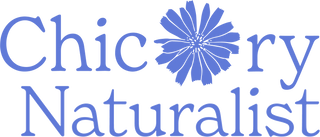
For Chicory’s inaugural blog post, I want to answer a few foundational questions: What is a field guide, what is a taxonomic key, and why the heck would you use either one of them when Google exists? This was a topic near and dear to my heart when I started foraging for wild mushrooms going on 7 years ago, and I’ve honestly only become more interested over time. Broadly speaking, a field guide is a book with detailed entries, often illustrated, used to make a firm identification of a particular species, variety, or breed.
I found a cool plant. Why not just type its description into Google, or take a photo of it with an app like iNaturalist?
My answer is: You can! That’s a great idea, and it might get you where you need to go, or it might get you in the neighborhood. The trouble is, it also might lead you to see pictures of a look-alike plant which someone has tagged incorrectly, and make an incorrect identification. You should always look at your search results and ask, do I know what I’m looking for?
The example I often use when thinking about identification is this: Imagine you grew up having no idea what a cucumber was. Never saw pictures, never ate it, maybe never heard the name. Then one day you see a cucumber hanging on a vine and you want to ID it, so you google what you see, and a mix of photos of cucumbers and zucchini come up. Are you able to tell the difference? For those of us who grew up seeing, touching, and smelling both cucumber and zucchini, the differences seem obvious and instinctual, but in fact they can be very subtle. The texture of the skin, the stem and how it attaches, the scent, the color of the flesh and the size and density of the seeds when you slice into it--you know what to look for.
This is the main reason to have a variety of field guides and learn how to use them: They teach you morphology! Morphology is similar to anatomy, but it deals with the external rather than internal structures of an organism. While some basic animal, plant, and fungi anatomy is taught in the average high school biology class, you’re unlikely to learn detailed morphology unless you take specialized courses in university or take an avid interest in identification as a pastime.
For aspiring foragers this is a requirement--you cannot safely harvest or prepare wild foods without being able to make certain IDs, and you cannot do that without knowing the relevant morphology--but for many people it becomes a passion in itself. For instance, while I haven’t been bit by the birding bug yet myself, I’ve heard from many sources that it can come on quite suddenly with age, like a midlife crisis with wings. I can only hope it goes that way for me, since a good pair of binoculars and some field guides are far more in my budget than a sports car.
For foragers specifically, many field guides have another excellent benefit: Helping you learn what you are NOT looking for. Field guides aimed at foragers usually have good, hopefully illustrated information about lookalikes attached to the entries for desirable species. In the example of telling a cucumber apart from a zucchini, the difference is not so important. I might not really care for a zucchini slice in my gin and tonic, but it’s not going to kill me. The same cannot be said for many wild plants and fungi, so the stakes get higher when you go looking for food outside of cultivated varieties.
So how do you use a field guide? And is it the same as a taxonomic key?
There’s no simple answer here. One of the most fun and confounding parts about field guides is that while they’re pretty much universally written by experts, there’s very little standardization in how they’re organized. Some do include a taxonomic key, which you may recall from biology class by another name, a dichotomous key. This is best described (in this nerd’s opinion), as a choose-your-own-adventure of morphology. Using a dichotomous key, you work through the differences between species in a series of binary choices, starting from the most general to the most specific. So for instance when identifying a tree, you begin by answering whether it is cone-bearing (coniferous) or broad-leaf (deciduous), and may end with a question of bud placement in relation to leaf scars.
If that seems a bit in the weeds for you at this juncture of your natural science journey, DON’T WORRY ABOUT IT. There are also many, many field guides that are organized to be very accessible to the uninitiated. An insect guide may sort by where you’re likely to see the species (on a flower or at the porch light). Or as with the Sibley Bird guides, some are organized by family (like shorebirds or woodpeckers) and include great illustrations of each species.
You have any number of free online guides and keys listed on your resources page. Why would I buy a guide?
This is fully a matter of preference, and I can only give you my own reasons for owning an ever-growing stack of current and vintage guides, even as online resources get better and better: First, I am a tactile learner in the extreme, so having a book to hold is something I will always value. Second, the structure of different guides is always illuminating to me, and I get a lot out of seeing how experts in a certain field see fit to organize their knowledge--it’s a window into someone’s brain. Thirdly, I like a pocket guide like this Berry Finder to take with me out into the world sometimes, specifically to avoid using my phone. I do take quite a lot of photos on nature walks, either to use as reference material for drawing or to try to ID later, but as we all know, it can be difficult to use one’s phone for just one thing. There’s a certain wisdom to the simplicity of paper and ink when the goal is immersion in nature.
Lastly, and perhaps most obviously: Field guides are generally beautiful objects. They are illustrated with meticulous drawings and photographs, and just flipping through can be an inspiration to push off the couch and get outside. I usually bring down a small stack around this time of year to place around the house--a promise of things to come.





